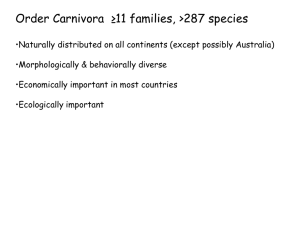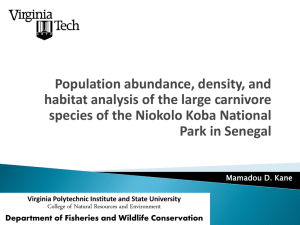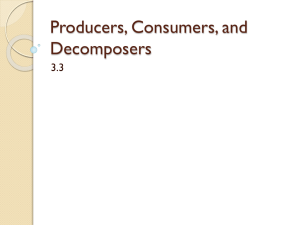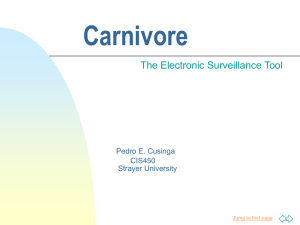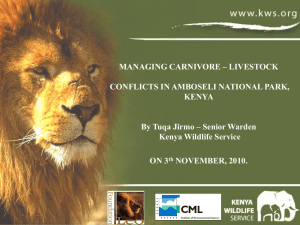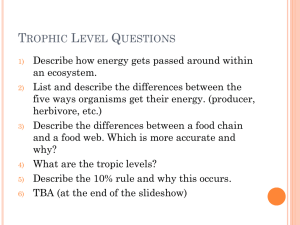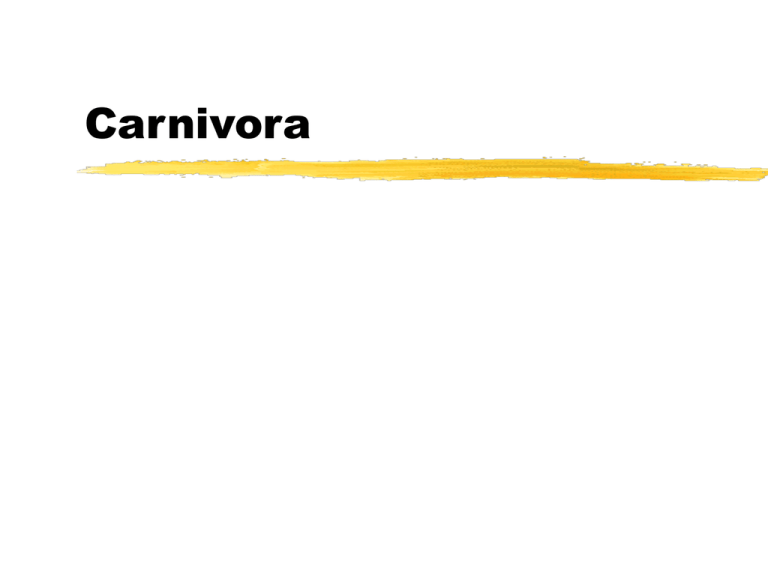
Carnivora
Carnivora
Carnivory and Carnivora are not synonyms.
Most carnivora are specialized for ‘meat’ eating,
but certainly not all.
Many other non-carnivora consume meat.
2 suborders:
Caniformia = dog like: possess alisphenoid canal
Feliformia = cat like: usually lack alisphenoid canal
Grey wolf: alisphenoid
California sea lion alisphenoid
White tiger: no alisphenoid canal
Hemigalus derbyanus: civet – note bullae
Nandinia binotata: palm civet
Carnivora
It is easy to see how cats and canids fit this
classification, but how about mustelids?
The 2 suborders are defined on the basis of
the auditory bullae and the carotid
circulation.
Furthermore, aquatic carnivores
(Odobenidae, Otariida, and Phocidae) are
pinnipeds (feather footed), while others are
fissipeds (split footed). These were once
suborders.
Carnivore Morphology
All carnivores have well developed
canines.
They possess carnassial teeth formed by
upper p4 and lower m1.
Carnassials are designed to shear through
muscle and soft tissue, and in some, to
slice through bone as well.
a: lion
b: hyaena
c: dog
d: marten
e: mongoose
f: bear
Carnivore Morphology
Skull shape reflects feeding strategy.
Compare the structure of the musculature
of carnivores and herbivores, as well as
the relative position of the mandibular
condyle.
Compare the
relative
positions of the
mandibular
condyles and
importance of
primary
chewing
muscles:
Temporalis in
carnivores and
masseters in
herbivores.
Carnivore Morphology
Mandibular fossa differs too.
It has a ‘c’ shape in many, especially
mustelids, that permits no lateral movement.
In procyonids and ursids, it is more likely to
more ‘open’, allowing more lateral movement.
Why do you think that is?
Note the
mandibul
ar fossa
in the
mustelid
and the
bear.
What
function
might
follow
this form?
Carnivore Morphology
An important diagnostic characteristic of
carnivores is the structure of the auditory
bulla. Recall, this is derived from the
angular bone of reptiles.
Recall, reptilian jaw articulation is
quadrate-articular, while mammalian is
dentary-squamosal.
Carnivore Morphology
Carnivores have 2 forms of auditory bullae
formed by tympanic bone
formed by tympanic and endotympanic.
In feliformes, the bullae are formed by
the tympanic and endotympanic, and
have a septum in between.
In caniformes, the bullae are formed by
the tympanic, and there is no septum.
Carnivore Morphology
Most carnivores have a baculum.
This is sort of interesting. What other
mammals have a baculum? Rodents. Why?
Carnivores also have induced ovulation!
Coincidence?
a: red fox
b: racoon
c: least weasel
d: mongoose
e: genet
f: lion
Carnivore Morphology
Most have anal sace used for intraspecific
communication (territoriality - home range
etc.)
Sometimes, these are used for defense
(skunks).
Absent in ursids, minimal in canids and
felids.
Carnivore Morphology
Claws are prominent except in clawless
otters (Aonyx), but even here they are
vestigal.
Felids and viverids often have retractile
claws.
No opposable digits.
Centrale, scaphoid, and lunar are fused.
Carnivore Morphology
Clavicle is reduced or absent.
Permits increased stride length.
Two ways to run faster: 1) increase stride rate or
2) increase stride length.
Note: many ungulates also lack a clavicle.
Some are digitigrade (felids and canids)
while others are plantigrade (ursids,
procyonids). Difference in speed?
Carnivore Morphology
Size range is considerable: least weasel
Mustela nivalis weighs 70g, while Ursus
arctos weighs 800kg. What is the
implication of this size range?
High protein diet has consequences for
the digestive tract (incl. reduced ceacum).
Carnivory, omnivory, and herbivory.
Carnivore Evolution
First fossil carnivore dates to the late
Cretaceous: Cimolestes.
Cimolestes is ancestral to both modern
carnivores and the creodonts.
Creodonts lasted to the Miocene.
Cimolestes (Cretaceous):
ancestral to creodonts?
Oxyaena (Creodont): carnassial is
formed by m1-2 and m2-3.
Sinopa, Eocene creodont w/ M2m3 carnassials.
Carnivore Evolution
2 lineages of early modern carnivores
Viverravidae
Miacidae
Both had P4/M1 carnassials.
Both are from the early Eocene.
Centrale, scaphoid, and lunar were not
fused.
Carnivore Evolution
Canids, felids, ursids, viverrids, and
mustelids appear by the Oligocene.
Radiation of carnivores mirrors adaptive
radiation of vegetation and potential prey
items.
Earliest pinnipeds (enaliarctids) date to
the late Oligocene.
Felimormia: Felidae
Worldwide dist’n except Australia, New
Zealand, Madagascar, Japan, Oceanic
Islands, and Poles.
36 species.
All have shortened rostrum.
What are the consequences of this in terms
of olfaction? Bite strength?
A) felid
B) canid
Note
different
proportions
of large
and small
felid skulls.
Is this an
allometric
effect?
Feliformia: Felidae
Felids kill via cervical dislocation, or
suffocation.
Note extreme reduction in non-essential
dentition.
Note reduction in molar
battery, emphasis on slicing.
Feliformia: Felidae
Size ranges from 2kg to 300kg.
Hyoid apparatus is cartilaginous resulting in ability to roar (purr in fifi).
Claws retractile - except cheetah.
Semi-arboreal.
Papilla on tongue are angled backwards.
Hunting & Social strategies?
Feliformia: Hyaenidae
Old world, large carnivores to 80kg.
4 genera and 4 species.
Are both effective predators and
scavengers.
Feldhammer asserts scavenging may
reduce competition between other
carnivores and hyaenids. In Serengetti,
most cats scavenge from hyaenids.
Feliformia: Hyaenidae
Can regurgitate undigestable items.
Digitigrade w/ nonretractile claws.
Fore-limb dominance is unusual. Why?
Protrusable anal scent glands.
Lack a baculum.
Spotted Females have pseudopenis.
Why? Also, females > males. Laughing
vocalizations.???
Compare
skull and
dentition of
striped
hyaena and
aardwolf.
Spotted Hyaena utr
Feliformia: Hyaenidae
Crocuta crocuta - spotted hyaena is
largest.
Hyaena hyaena - striped hyaena.
Parahyaena brunnea - brown hyaena
Proteles cristatus - Aardwolf
Feliformia: Herpestidae
Old world: 18 genera and 37 species of
mongooses.
Recently separated from viverids..
Size varies from 0.3kg to 5kg.
Feeding generalists.
Solitary - social. Terrestrial semiarboreal.
Herpestes javanicus introduced to Hawaii.
Egyptian mongoose: Herpestes
ichneumon.
Feliformia: Viverridae
20 genera and 34 species of Civets and genets.
Old world.
Only mammalian carnivore on Madagascar.
Wide variety of feeding styles: Frugivorous omnivorous - carnivorous.
Peri-anal gland produces ‘civet. Civet uses this
for scent marking, we use it for perfume.
Note the
similarity of
the skulls:
hence the
previous
unity of the
families.
Genetta genetta: Small spotted
genet.
Caniformia: Canidae
13 genera and 33 species of ‘dogs,’ in new
and old worlds.
Dingo (Canis lupus dingo) was introduced
to Australia and New Guinea about 4000
years ago.
Size varies from 1kg in Fenec to 80kg
grey wolf.
Tend to be open, 2d hunters.
Caniformia: Canidae
Long limbs, nonretractile claws.
Long rostrum = good olfaction.
Oldest fossil dates to oligocene of NA:
Hesperocyon.
Problems w/ taxonomy of ‘red wolf’.
Canis latrans
Caniformia: Mustelidae
25 genera and 65 species of badgers,
weasels, skunks, wolverine, and otters.
Primarily northern hemisphere.
Exclusively carnivorous. High energy diet
goes along w/ northern distribution and
high sa/v ratio.
Long bodies, short limbs. 30g Mustela
nivalis to 55kg Gulo gulo.
Caniformia: Mustelidae
Anal scent glands - think skunk.
Monestrous, some have induced
ovulation, some have delayed
implantation.
Taxidae taxus
Meles meles
Zorilla: African mustelid.
Note skull profiles.
Caniformia: Procyonidae
6 genera and 18 species restricted to new
world.
1kg ringtail cat Bassariscus astutus to
18kg racoons.
Sexual dimorphism.
Kinkajou Potos flavus has prehensile tail.
Kinkajou skulls and teeth follow.
Compare
skull
profiles
between
canids and
procyonids.
Procyon: lack of allisphenoid canal
Procyon lotor
Procyon lotor
Procyon lotor:
carnassials?
Nyctereutes procyanoides.
Caniformia: Ursidae
Historically: N. America, Andes of S.
America, Eurasia, Atlas Mts. of N. Africa,
in Arctic to tropical forests.
6 genera and 19 species (including
greater and lesser pandas).
5kg lesser panda to 800kg grizzly.
Sexual dimorphism is 20% in
monogamous forms, and 100% in
polygamous forms.
Dentition
geared to
omnivory?
Caniformia: Ursidae
Only polar bears are strict carnivores.
Bears do not hibernate.
Grizzly bears once occurred in Mexico!
Caniformia: Pinnipedia
Pinnipeds are not entirely aquatic: they
haul out for reproduction and to rest.
Morphologically similar because of
constraints of aquatic and terrestrial life
styles.
Phocids
Otariids
Odobenids
Caniformia: Pinnipedia
Fusiform
Genetalia are tucked away as in
cetaceans.
Subcutaneous fat: energy storage,
insulation, and laminar flow.
Propulsion by forelimbs in otariids and
odobenids - by hindlimbs in phocids.
Can you infer
propulsive
mechanism
based on
vertebral
column?
Caniformia: Pinnipedia
Dentition usually tends to homodonty.
Why?
There are exceptions: Crab eater seals
Lobodon carcinophagus. (Crab eater seals
actually eat krill which they filter from the
water).
a, b) phocid: harbor seal. c, d) otariid:
stellar sea lion and crab eater seal.
Lobodon carcinophagus
Caniformia: Pinnipedia
Curvature of eye enhances visionunder
water, but poor vision on land. Have
Tapetum lucida.
Good hearing under water to locate prey.
Diving adaptations: Bradycardia, blood
shunting, increased hemoglobin +
myoglobin.
Odobenidae
Monotypic. Includes only the walrus Odobenus
rosmarus.
Dist’n is circumpolar in arctic.
Mass to 1600kg. Sexual dimorphism.
Blubber layer to 15cm
Like otariids, ventral surface of flippers is
naked, and nails on 1st and 5th digits of hind
flippers are rudimentary.
Odobenidae
Tusks in males and females: enlarged
canines.
Tusks lack enamel.
Tusks are used in aggressive encounters,
establishing dominance heirarchies, for
feeding, locomotion, breaking through ice.
Otariidae
These are the eared seals. Includes fur seals
and sea lions.
Marine only, in subpolar, temperate, or coastal
waters.
7 genera and 14 species.
Otariinae are the sea lions and have blunt
noses and little underfur.
Arctocephalinae have pointed noses and lots of
underfur.
Otariidae
Feed on fish, crustaceans, and
cephalopods.
Gregarious - may occur in groups
containing up to a million individuals.
Breed on land. Males are polygynous and
defend territories with 3 to 40 females.
Most exhibit delayed implantation.
Phocidae
True seals.
10 genera and 19 species, in both polar and
subpolar water.
2 subfamilies:
Phocinae of N. hemisphere have well-developed
claws on all flippers.
Monachinae includes monk seals, elephant seals,
and antarctic seals - reduced claws on hind flippers.
Phoca vitulina
Phocidae
Mass varies from 35kg to 3700kg.
Generally lack underfur.
Cheek teeth are multicusped.
Not gregarious and do not form large
breeding colonies.
Breed on the ice: note position of rear
flippers and limited terrestrial locomotor
abilities.
Phocidae
Delayed implantation.
Dive deeper and stay down longer than
otariids.

